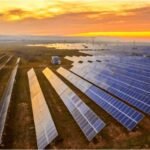Introduction to Solar Energy
Solar energy is increasingly recognized as a sustainable and clean source of electricity, derived from harnessing the power of the sun. This renewable energy source works by capturing sunlight through solar panels, which convert light into electricity. Solar panels consist of numerous photovoltaic (PV) cells that utilize photovoltaic technology, allowing them to generate power when exposed to sunlight. This process not only provides an efficient means of producing electricity but also contributes significantly to the reduction of greenhouse gas emissions, making it an environmentally friendly alternative to fossil fuels.
One compelling aspect of solar energy is its potential to alleviate dependence on traditional energy sources, which often entail substantial environmental costs. The adoption of solar technology fosters a decrease in an individual’s or business’s carbon footprint, a critical factor in combating climate change. As more households and companies install solar panels, the cumulative impact on reduction in carbon emissions becomes substantial, contributing to a cleaner environment and enhanced air quality.
Moreover, the financial benefits of transitioning to solar energy cannot be overlooked. Installing solar panels can lead to significant savings on energy bills, particularly in areas where electricity costs are high. Many governments provide incentives, such as tax credits and rebates, further enhancing the economic appeal of solar installation. Over time, the initial investment in solar technology often pays off through lower utility bills and increased property value. As energy prices continue to fluctuate, solar energy stands out as a stable and predictable source of energy cost management.
In summary, transitioning to solar energy not only presents an opportunity to harness a reliable and renewable energy source, but it also promotes sustainability, supports financial savings, and aids in the fight against climate change.
Understanding Solar Panels
Solar panels, also known as photovoltaic (PV) panels, are devices that convert sunlight into electrical energy. At their core, these panels consist of numerous solar cells made primarily from silicon, which is a semiconductor material. When solar radiation strikes these cells, it induces a flow of electricity, thus converting solar energy into usable electrical power. Understanding the different types of solar panels available is crucial for anyone considering installation.
The three main types of solar panels are monocrystalline, polycrystalline, and thin-film. Monocrystalline panels are recognized for their high efficiency and longevity. They are made from a single continuous crystal structure, which allows them to absorb more sunlight, making them ideal for smaller spaces where maximum power output is desired. Conversely, polycrystalline panels consist of multiple crystal structures and are generally less efficient than monocrystalline variants but are more cost-effective, making them a popular choice for residential installations.
Thin-film solar panels, the third type, are made from a variety of materials and are known for their lightweight and flexible design. While they have lower efficiency ratings compared to the crystalline types, their versatility allows for applications on surfaces where traditional panels might not fit. Each type of panel has its advantages, and the choice largely depends on the specific energy needs and budget of the user.
Efficiency ratings, typically expressed as a percentage, indicate how effectively a solar panel converts sunlight into electricity. Recent advancements in solar technology have led to improved efficiency rates, with many panels exceeding 20%. As the industry continues to innovate, selecting the right panel type and understanding its workings are essential steps toward harnessing solar energy effectively.
Assessing Your Home’s Solar Potential
Before deciding to install solar panels, it is crucial to assess your home’s potential for solar energy production. Several factors can influence the effectiveness and efficiency of solar panels, including roof orientation, shading, and geographic location. Understanding these factors will help you determine whether solar energy is a viable option for your household.
The orientation of your roof plays a significant role in solar energy generation. Ideally, roofs that face south receive the maximum sunlight exposure, resulting in greater energy production. However, east- or west-facing roofs can also provide substantial solar energy, particularly if they are unshaded for large portions of the day. It is advisable to measure the angle and direction of your roof, as this will impact the performance of any solar panels installed.
Shading from nearby trees, buildings, or other obstructions can considerably reduce the effectiveness of solar panels. To evaluate shading, observe your roof during different times of the day and seasons. If shadows fall on your roof for significant portions of time, you may need to consider trimming trees or relocating obstacles to maximize sun exposure. In some cases, solar panel placement may also be adjusted to mitigate shading effects.
Your geographic location is another critical component when assessing solar potential. Regions with higher average sunlight hours per day will benefit more from solar panel installations. Various online resources and tools can provide insights into the solar resources available in your area. Additionally, consider local climate conditions, which can impact overall solar energy generation.
Finally, conducting a solar assessment can provide you with a more accurate understanding of your home’s potential for solar energy. Engaging with a professional solar installer can help you evaluate these factors comprehensively, ensuring that you make an informed decision regarding the installation of solar panels.
Planning the Installation Process
Embarking on the journey to install solar panels involves careful planning and several critical steps. The first step in this process is selecting a qualified solar provider. It is imperative to conduct thorough research to find a reputable company that offers the necessary expertise and has an established track record in solar panel installations. Often, seeking recommendations from friends or family and reviewing online testimonials can aid in making an informed decision.
Once a solar provider has been selected, the next step involves obtaining the necessary permits. The requirements for permits can vary widely based on location and local regulations. Most regions require homeowners to secure permits before the installation can commence. This step is crucial, as failing to obtain the correct permits can lead to delays or legal complications down the line. It is advisable to have the solar provider assist with the permitting process, as they will have experience navigating local regulations and can facilitate a smoother approval.
Understanding the timeline for the installation process is also a significant aspect of planning. Typically, the installation process can take anywhere from a few weeks to a couple of months, depending on various factors such as the complexity of the installation, the availability of materials, and weather conditions. Anticipating potential delays and remaining flexible with timelines can contribute to a more manageable process. It is beneficial to maintain open lines of communication with the solar provider throughout all stages, as they can provide updates and assist in addressing any issues that may arise.
In conclusion, careful planning and collaboration with qualified professionals are essential for a successful solar panel installation. By selecting the right provider, securing necessary permits, and understanding timelines, homeowners can pave the way for a smooth transition to solar energy.
Financing Options for Solar Panels
When considering the installation of solar panels, exploring various financing options is crucial to determining the most suitable strategy for your financial situation. There are several approaches to financing solar panels, each offering unique benefits and potential drawbacks. The most straightforward option is a cash purchase, which allows homeowners to pay for their solar system upfront. This method eliminates monthly payment obligations and ultimately provides the best return on investment due to the elimination of interest rates.
Alternatively, solar loans have gained popularity as they enable individuals to finance their solar systems over time. With various loan programs available, including secured loans and unsecured personal loans, homeowners can select terms that fit their budgets. Solar loans typically have low-interest rates and can often be secured to match or be lower than the energy savings generated by the solar system itself.
Another option to consider is leasing. When homeowners choose to lease solar panels, they do not own the system. Instead, they pay a fixed monthly amount to a solar provider for using the panels, making this an attractive option for those who prefer lower upfront costs. However, leasing ties homeowners to a long-term commitment, typically ranging from 20 to 25 years, and they may miss out on gaining equity in the system.
Power Purchase Agreements (PPAs) are also noteworthy financing models. Under a PPA, a solar provider installs the system on a homeowner’s property and charges them a predetermined rate for the energy produced. This setup can lead to savings on monthly energy bills while minimizing any upfront investment. It is vital for homeowners to evaluate state and federal incentives, as well as available tax credits and rebates, as these can significantly lower the overall costs associated with solar panel installation.
Understanding Solar Panel Maintenance
Maintaining solar panels is crucial for ensuring their optimal performance and longevity. Regular maintenance not only protects your investment but also maximizes energy production. One key aspect of solar panel maintenance is cleaning. Dust, dirt, and debris can accumulate on the panels, reducing their efficiency. It is advisable to clean your solar panels at least twice a year, or more frequently if you live in a particularly dusty area. Using water and a soft brush is the best practice. Avoid harsh chemicals, as they may damage the surface of the panels.
In addition to regular cleaning, monitoring the energy output of your solar system is essential. Most systems come equipped with monitoring software that allows homeowners to track energy production in real-time. This data can reveal any inconsistencies, such as a sudden drop in output that may indicate a need for maintenance or repairs. Regularly checking this information can help you identify potential issues before they escalate, allowing for timely intervention.
When it comes to repairs or professional service, knowing when to call in experts can save you both time and money. If you notice that your solar panels are not generating energy as expected, or if there are visible signs of damage, it is crucial to consult with a solar professional. Technicians can conduct thorough inspections, identify underlying issues, and recommend necessary fixes. Some common repairs may involve checking the inverter, wiring, or even structural concerns related to mounting. Overall, regular maintenance and monitoring, coupled with professional support when needed, will ensure that your solar panels operate efficiently for years to come.
Potential Challenges and Downsides
While solar panels represent a promising solution for renewable energy, there are several potential challenges and downsides that one must consider before installation. One of the most significant concerns is the high upfront costs associated with purchasing and installing a solar energy system. Despite the long-term savings on electricity bills, the initial investment can be daunting for many homeowners. However, it’s important to recognize that various financing options, government incentives, and tax credits can help mitigate this expense, making solar energy more accessible.
Another challenge faced by solar panel systems is their dependency on sunlight. The efficiency of solar panels is directly linked to the amount of sunlight they receive, which means their energy generation can be significantly affected by weather patterns, seasonal changes, and geographical location. In areas with frequent overcast or rainy conditions, homeowners may find their systems underperforming. To address this concern, it is advisable to conduct a thorough analysis of potential solar energy production based on local weather data before proceeding with installation. Furthermore, integrating battery storage systems can offer solutions to store excess energy generated during sunny days for use during less favorable conditions.
Space requirements also pose a challenge, as solar panel installations demand a substantial amount of roof or ground space for optimal efficiency. Not every property may have the adequate square footage to accommodate a full solar energy setup. For properties with limited space, considerations such as solar roof tiles or alternative high-efficiency models might be worthwhile. Additionally, shared solar programs could provide an alternative for those unable to install panels on their premises, allowing participation in a larger solar farm.
Solar Energy and Environmental Impact
Solar energy offers a myriad of environmental benefits, making it a compelling alternative to fossil fuels. One of the most significant advantages is the considerable reduction in greenhouse gas emissions associated with solar power generation. Unlike conventional energy sources, such as coal and natural gas, solar panels convert sunlight directly into electricity without emitting harmful pollutants. This transition to clean energy sources has the potential to significantly mitigate climate change by decreasing the concentration of carbon dioxide and other greenhouse gases in the atmosphere.
In addition to lowering emissions, solar energy also plays a crucial role in conserving water resources. Traditional power generation methods, particularly those employed in fossil fuel and nuclear power plants, require substantial water for cooling processes. In contrast, solar panels operate without depleting fresh water supplies, presenting a sustainable solution to energy generation in water-scarce regions. This quality enables solar power to contribute positively to water management, especially as global populations grow and freshwater resources become increasingly strained.
While the environmental impacts of solar energy are generally favorable, it is essential to consider the lifecycle impacts of solar panels. The manufacturing of solar panels involves resource extraction and energy-intensive production processes that can generate waste and emissions. Materials such as silicon, silver, and other metals are involved in the creation of these panels, raising concerns about the environmental ramifications of mining and processing them. Furthermore, the disposal of solar panels at the end of their lifespan can pose environmental challenges if not managed correctly. It is crucial to develop recycling processes and innovations in solar technology to ensure that the environmental benefits of solar energy continue to outweigh its lifecycle impacts.
Conclusion: Making Informed Decisions
As we have explored throughout this blog post, the integration of solar panels into your energy framework is a multifaceted decision that requires thoughtful consideration. Understanding how solar energy works, the initial investment involved, potential savings, and the available incentives is crucial when contemplating installation. By being well-informed, individuals can better assess how solar energy aligns with their specific energy needs and financial goals.
Solar panels not only offer a sustainable and renewable source of energy, but they also contribute to reducing your carbon footprint and promoting environmental conservation. Consequently, selecting solar energy is not merely an economic choice but also a significant step towards supporting eco-friendly practices. It is essential for homeowners and businesses alike to consider the long-term benefits of solar power, including energy independence, potential tax credits, and increases in property value.
Furthermore, engaging with reputable solar providers and understanding the various financing options available can empower you to make educated decisions. Thorough research into the types of solar panels, their efficiency ratings, and warranty terms can safeguard your investment and ensure you choose the right system for your unique circumstances.
In closing, embracing solar energy is a progressive path that not only meets today’s energy demands but also secures a sustainable future. Whether you are motivated by financial incentives, environmental impact, or both, making informed decisions about solar panel installations will ultimately lead to more satisfactory outcomes. Take the next step by evaluating your specific needs and considering solar panel technology as a solution to modern energy challenges.


